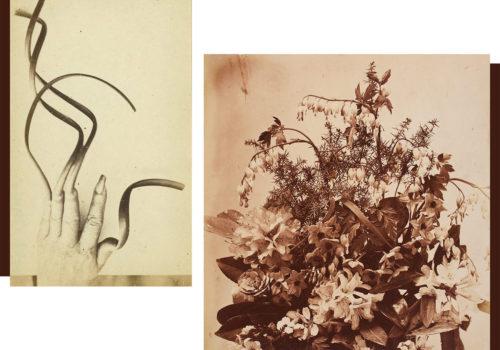This is the twenty-sixth dialogue from the Ettore Molinario Collection, a dialogue within French photography and outside the borders of France, where its colonial empire grew in the 19th century. And growth is precisely the theme of this encounter between Adolphe Braun and Émile Gsell. Whether flowers or nails, we are talking about the force of nature. And surprisingly, a gift of love.
Ettore Molinario
He must have seen them going up the Mekong, and they were not yet those spectacular nails, but lianas that wrapped around the trunks, mangroves and rivulets of current that anticipated the danger of the rapids. In June 1866, a century and a half ago, Émile Gsell was hired as a photographer by the Commission d’exploration du Mékong and set off to discover that mythical river in the wake of Ernest Doudart de Lagrée. In Cochinchina, Émile had arrived at the age of twenty-eight as a soldier in the French army and in addition to his military training had received an enviable photographic training, so much so that photography had become his calling. Sailing from Cambodia to Siam, to which the temple ruins of Angkor Wat then belonged, Gsell had discovered a powerful nature and an architecture that joined and echoed it. That embrace was another way to grow. To the elegance of the gardens, boulevards and parks that dotted Paris, and thus to the gracefulness of Adolphe Braun’s splendid floral arrangements, was countered an inner force, wild, anarchic, immeasurably free to express itself.
In 1850, Adolphe Braun, a skilled draughtsman and graphic designer in charge of a studio that supplied patterns for fabrics and wallpapers, had started photographing dahlias, peonies, hydrangeas, tulips, carnations, roses, rhododendrons, and then ears of corn, leaves and field grasses. By 1855, three hundred of these images, of the highest quality and already a ‘product’ of the emerging photographic industry, had been collected in the gigantic portfolio Fleurs photographiées and presented at the International Exhibition in Paris to the acclaim of Empress Eugénie. Blooming in every domestic space, from walls to furnishings to clothes, Braun’s works had the not inconsiderable task of bringing nature, cut down and domesticated, into the everyday life of the city and its inhabitants. This is how one grew up in a bourgeois drawing room.
In the East, Émile Gsell had discovered instead that even the body could blossom and change shape, and the proof lay in those very long nails, male and female, that looked like shoots and stems prefiguring the energy of Art Nouveau. Perhaps one of the most famous images, an emblem of an exotic strangeness, saleable in the West, was the hand of a dignitary from the kingdom of Annam, formerly China and now Vietnam, which Gsell had portrayed between 1866, when he opened the first photographic studio in Saigon, and 1879, the year of his death. The possessor of such an exuberance of keratin has thus nobly declared his rejection of all contact. Yet that arabesque that stretches the fingers and makes the hand a garden is also a gift and therefore a bond. In a poem by Chao Chai, a poetess of the Tang dynasty, a woman decides to offer her lover what is most precious to her and so she cuts her nails, which have been growing protected for years, wraps them in silk and sends them to the man far away. A thousand years later, in the novel The Dream of the Red Chamber, Ts’ao Hsüeh-ch’in – a mandarin whose family oversaw the imperial textile factories – tells of a maid who, on her deathbed, also cuts her nails and offers them to her lord as proof of affection and eternal devotion. We cut a flower and let a life, a spring outside of us, speak of love on our behalf. Elsewhere the gift is growth, it is time taking shape, it is our body becoming nature.
Ettore Molinario
www.collezionemolinario.com
















